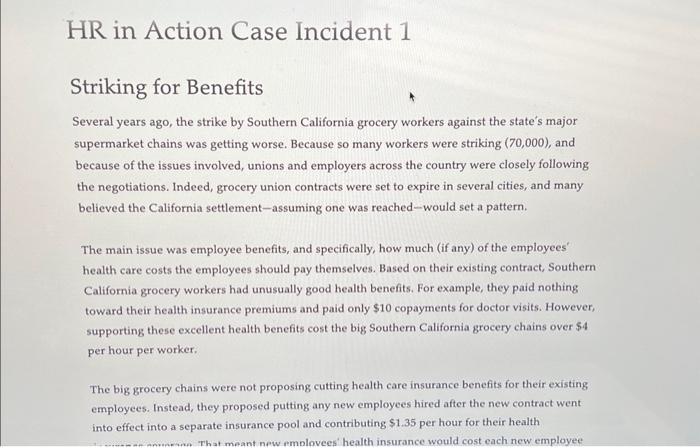


Striking for Benefits Several years ago, the strike by Southern California grocery workers against the state's major supermarket chains was getting worse. Because so many workers were striking (70,000), and because of the issues involved, unions and employers across the country were closely following the negotiations. Indeed, grocery union contracts were set to expire in several cities, and many believed the California settlement-assuming one was reached-would set a pattern. The main issue was employee benefits, and specifically, how much (if any) of the employees' health care costs the employees should pay themselves. Based on their existing contract, Southern California grocery workers had unusually good health benefits. For example, they paid nothing toward their health insurance premiums and paid only $10 copayments for doctor visits. However, supporting these excellent health benefits cost the big Southern California grocery chains over $4 per hour per worker. The big grocery chains were not proposing cutting health care insurance benefits for their existing employees. Instead, they proposed putting any new employees hired after the new contract went into effect into a separate insurance pool and contributing $1.35 per hour for their health The big grocery chains were not proposing cutting health care insurance benefits for their existing employees. Instead, they proposed putting any new employees hired after the new contract went into effect into a separate insurance pool and contributing \$135 per hour for their health insurance coverage. That meant new employees' health insurance would cost each new employee perhaps $10 per week. And, if that $10 per week weren't enough to cover the cost of health care, then the employees would have to pay more, or do without some of their benefits. It was a difficult situation for all the parties involved. For the grocery chain employers, skyrocketing health care costs were undermining their competitiveness) the current employces feared any step down the slippery slope that might eventually mean cutting their own health benefits. The unions didn't welcome a situation in which they dend up representing two classes of employees, one (the existing employees) who had excellent health insurance benefits, and another (newly hired employees) whose benefits were relatively meager, and who might therefore be unhappy from the moment they joined the union. 11-17. Assume you are mediating this dispute. Discuss five creative solutions you would suggest for how the grocers could reduce the health insurance benefits and the cost of their total benefits package without making any employees pay more. 11-18. From the grocery chains' point of view, what is the downside of having two classes of employees, one of which has superior health insurance benefits? How would you suggest they handle the problem? 11-19. Similarly, from the point of view of the union, what are the downsides of having to represent two classes of employees, and how would you suggest handling the situation? Striking for Benefits Several years ago, the strike by Southern California grocery workers against the state's major supermarket chains was getting worse. Because so many workers were striking (70,000), and because of the issues involved, unions and employers across the country were closely following the negotiations. Indeed, grocery union contracts were set to expire in several cities, and many believed the California settlement-assuming one was reached-would set a pattern. The main issue was employee benefits, and specifically, how much (if any) of the employees' health care costs the employees should pay themselves. Based on their existing contract, Southern California grocery workers had unusually good health benefits. For example, they paid nothing toward their health insurance premiums and paid only $10 copayments for doctor visits. However, supporting these excellent health benefits cost the big Southern California grocery chains over $4 per hour per worker. The big grocery chains were not proposing cutting health care insurance benefits for their existing employees. Instead, they proposed putting any new employees hired after the new contract went into effect into a separate insurance pool and contributing $1.35 per hour for their health The big grocery chains were not proposing cutting health care insurance benefits for their existing employees. Instead, they proposed putting any new employees hired after the new contract went into effect into a separate insurance pool and contributing \$135 per hour for their health insurance coverage. That meant new employees' health insurance would cost each new employee perhaps $10 per week. And, if that $10 per week weren't enough to cover the cost of health care, then the employees would have to pay more, or do without some of their benefits. It was a difficult situation for all the parties involved. For the grocery chain employers, skyrocketing health care costs were undermining their competitiveness) the current employces feared any step down the slippery slope that might eventually mean cutting their own health benefits. The unions didn't welcome a situation in which they dend up representing two classes of employees, one (the existing employees) who had excellent health insurance benefits, and another (newly hired employees) whose benefits were relatively meager, and who might therefore be unhappy from the moment they joined the union. 11-17. Assume you are mediating this dispute. Discuss five creative solutions you would suggest for how the grocers could reduce the health insurance benefits and the cost of their total benefits package without making any employees pay more. 11-18. From the grocery chains' point of view, what is the downside of having two classes of employees, one of which has superior health insurance benefits? How would you suggest they handle the problem? 11-19. Similarly, from the point of view of the union, what are the downsides of having to represent two classes of employees, and how would you suggest handling the situation









